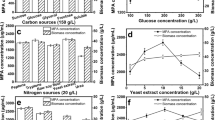Abstract
In this paper, we conducted a statistical optimization of the medium components for the production of rifamycin SV byAmycolatopsis mediterranei MM2. In order to maximize the yield of rifamycin SV, a Plakett-Burman experimental design (PBD) was initially utilized in the screening of the medium components among 11 nutrients. Glycerol and yeast extract were determined to influence significantly the yield of rifamycin SV. Then, a central-composite experimental design (CCD) was utilized in order to optimize the concentrations of the screened components accqired using the PBD and to predict the mutual interactions occurring between the screened components. The predicted optimal glycerol and yeast extract concentrations were determined to be 43.8 and 9.5 g/L, respectively. At this optimum point, the predicted rifamycin SV yield was 490.5 mg/L, whereas the corresponding experimental yield was 480.3±43.8 mg/L.
Similar content being viewed by others
References
Floss, H. G., and T.-W. Yu (2005) Rifamycin—Mode of action, resistance, and biosynthesis.Chem. Rev. 105: 621–632.
Sanfilippo, A., C. Della Bruna, L. Marsili, E. Morvillo, C. R. Pasqualucci, G. Schioppacassi, and D. Ungheri (1980) Biological activity of a new class of rifamycins, Spiro-piperidyl-rifamycins.J. Antibiot. 33: 1193–1198.
Murali Krishna, P. S., G. Venkateswarlu, and L. Venkateswar Rao (1999) Production of rifamycin SV using mutant strains ofAmycolatopsis mediterranei MTCC17.World J. Microbiol. Biotechnol. 15: 741–743.
Murali Krishna, P. S., G. Venkateswarlu, A. Pandey, and L. Venkateswar Rao (2003) Biosynthesis of rifamycin SV byAmycolatopsis mediterranei MTCC17 in solid cultures.Biotechnol. Appl. Biochem. 37: 311–315.
Murali Krishna, P. S., G. Venkateswarlu, and L. Venkateswar Rao (2000) Effect of uracil on rifamycin SV production byAmycolatopsis mediterranei MV35R.Lett. Appl. Microbiol. 31: 73–76.
El-Enshasy, H. A., U. I. Beshay, A. I. El-Diwany, H. M. Omar, A. G. El-Kholy, and R. El-Najar (2003) Improvement of rifamycins production byAmycolatopsis mediterranei in batch and fed-batch cultures.Acta Microbiol. Pol. 52: 301–313.
Abu-Shady, M. R., A. I. El-Diwany, M. A. Farid, and H. A. El-Enshasy (1995) Studies of rifamycin production byAmycolatopsis mediterranei cells immobilized on glass wool.J. Basic Microbiol. 35: 279–284.
Xu, J., E. Wan, C.-J. Kim, H. G. Floss, and T. Mahmud (2005) Identification of tailoring genes involved in the modification of the polyketide backbone of rifamycin B byAmycolatopsis medeterranei S699.Microbiology 151: 2515–2528.
Sen, R., and T. Swaminathan (1997) Application of response-surface methodology to evaluate the optimum environmental conditions for the enhanced production of surfactin.Appl. Microbiol. Biotechnol. 47: 358–363.
Kim, Y.-B., J.-H. Park, W.-J. Chang, Y.-M. Koo, E.-K. Kim, and J.-W. Kim (2006) Statistical optimization of the lysis agents for gram-negative bacterial cells in a microfludic device.Biotechnol. Bioprocess Eng. 11: 288–292.
Shi, F., Z. Xu, and P. Cen (2006) Optimization of γ-polyglutamic acid production byBacillus subtilis ZJU-7 using a surface-response methodology.Biotechnol. Bioprocess Eng. 11: 251–257.
Omar, R., M. A. Abdullah, M. A. Hasen, M. Marziah, and M. K. Siti Mazlina (2005) Optimization and elucidation of interactions between ammonium, nitrate and phosphate inCentella asiatica cell culture using response surface methodology.Biotechnol. Bioprocess Eng. 10: 192–197.
Vohra, R. M., and S. Dube (1989) Identification and quantitation of rifamycins by reversed-phase high-performance liquid chromatography.J. Chromatogr. 477: 463–466.
Author information
Authors and Affiliations
Corresponding author
Rights and permissions
About this article
Cite this article
Shin, H.J., Kim, CJ. & Kim, S.B. Optimization of culture medium for rifamycin SV production byAmycolatopsis mediterranei MM2 using statistical designs. Biotechnol. Bioprocess Eng. 12, 457–461 (2007). https://doi.org/10.1007/BF02931071
Received:
Accepted:
Issue Date:
DOI: https://doi.org/10.1007/BF02931071




